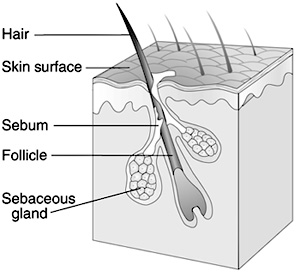5.3B: Sebaceous (Oil) Glands
- Page ID
- 7431
Sebaceous glands are found in most of the skin (except the palms of the hands and the soles of the feet).
LEARNING OBJECTIVE
Describe the location and function of sebaeous glands
Key Takeaways
Key Points
- Sebaceous glands are located throughout the skin except in the palms of the hands and soles of the feet.
- Sebum is an oily substance composed of fat (lipids) and the debris of dead fat-producing cells.
- Sebaceous glands are classified as holocrine glands.
Key Terms
- sebum: A thick oily substance, secreted by the sebaceous glands of the skin, that consists of fat and cellular debris.
- holocrine gland: The sebaceous gland is an example of a holocrine gland because its product of secretion (sebum) is released with remnants of dead cells.
Sebaceous glands are the oil secreting glands of your body. This is why they are also called the oil glands. They are a type of holocrine simple saccular (alveolar) gland. Their function is to secrete a substance called sebum, a mixture of fatty substances, entire sebum-producing cells, and epithelial cell debris. The sebaceous glands are located in the dermis, the middle layer of the skin, and they develop from the epithelial cells of the hair follicle itself (the external root sheath of the hair follicle).
Sebaceous gland ducts thus usually open up into the upper part of a hair follicle, called the infundibulum. The infundibulum is part of the pilosebaceous canal, the one responsible for discharging sebum and one that is composed of the infundibulum and the short duct of the sebaceous gland itself. However, some sebaceous gland ducts open directly onto our skin surface such as at the corner of the mouth and the glans penis. Regardless, the secretion of sebum out of the gland is helped along by the contraction of the arrector pili muscle.
While the sebaceous glands are present just about all over the skin, they are notably absent on the palms of the hands and the soles of the feet. The sebum being excreted by your body today began production around 8 days ago.
The Function of Sebum

Sebaceous Gland: Schematic view of a hair follicle with sebaceous gland.
The sebum produced by these glands plays numerous important roles:
- Sebum is a lubricant and inasmuch it helps to moisturize the skin. It does so by preventing the excess evaporation of water from the skin.
- Sebum serves to keep us healthy by keeping in check the growth of certain bacteria on our skin. That’s because sebum contains chemicals that kill bacteria. This helps ensure bacteria don’t invade into deeper layer of our skin.
- It helps to condition the hair. Meaning, it ensures our hair doesn’t become too dry and brittle.
Sebaceous glands are involved in numerous conditions. During puberty, various hormones cause them to produce a lot of sebum and this therefore contributes to oily skin. If a duct of a sebaceous gland is clogged with sebum, a whitehead results. If this material is allowed to dry and oxidize, it will become darker, forming a blackhead. If a sebaceous gland becomes infected, moderate and severe forms of acne are the result.
The glands lining the ear canal that produce earwax (cerumen) are called ceruminous glands. They are modified sebaceous glands.

